
Farrah Leni Fawcett was an American actress. A four-time Primetime Emmy Award nominee and six-time Golden Globe Award nominee, Fawcett rose to international fame when she played a starring role in the first season of the television series Charlie's Angels.
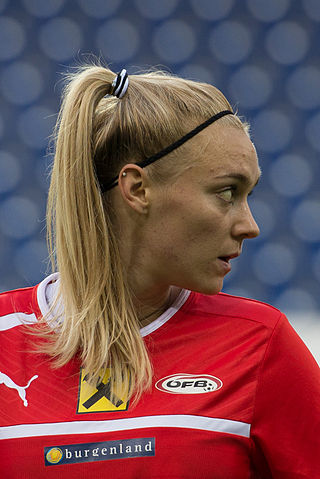
A ponytail is a hairstyle in which some, most, or all of the hair on the head is pulled away from the face, gathered and secured at the back of the head with a hair tie, clip, or other similar accessory and allowed to hang freely from that point. It gets its name from its resemblance to the tail of a pony.

The quiff is a hairstyle that combines the 1950s pompadour hairstyle, the 1950s flattop, and sometimes a mohawk. It was born as a post-war reaction to the short and strict haircuts for men. The hairstyle was a staple in the British Teddy Boy movement, but became popular again in Europe in the early 1980s and experienced a resurgence in popularity during the 1990s.

The mohawk is a hairstyle in which, in the most common variety, both sides of the head are shaven, leaving a strip of noticeably longer hair in the center. Mohawk hairstyles have existed for thousands of years. As of the 21st century, they are most commonly associated with non-conformity.

Cornrows are a traditional style of braids in which the hair is braided very close to the scalp, using an underhand, upward motion to make a continuous, raised row. Cornrows are often done in simple, straight lines, as the term implies, but they can also be styled in elaborate geometric or curvilinear designs.
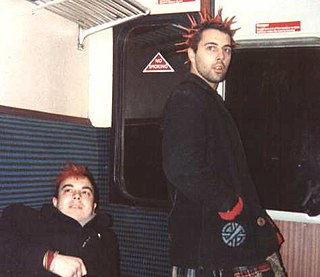
Liberty spikes is hair styled into long, thick, upright spikes. The style, now associated with the punk subculture, is so named because of the resemblance to the diadem crown worn by the Statue of Liberty, itself inspired by the Roman goddess Libertas and god Sol Invictus.

A bouffant is a type of puffy, rounded hairstyle characterized by hair raised high on the head and usually covering the ears or hanging down on the sides.

Big hair is a hairstyle that emphasizes large volume or largely styled hair, especially when those styles make the hair occupy a large amount of space above and around the head. The label "big hair" for such styles originated in the late 1970s, when these styles were beginning a period of popularity. Similar styles have become fashionable at various periods in history.
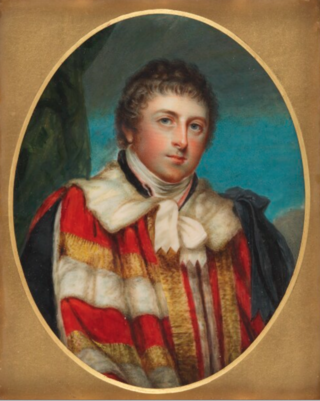
An eponymous hairstyle is a particular hairstyle that has become fashionable during a certain period of time through its association with a prominent individual.
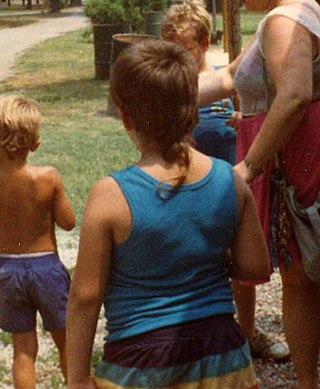
A rattail is a hair style that is characterized by a long "tail"-like element of hair growing downward from the back of the head. The rattail usually hangs naturally; however, it can be braided, treated as a dread, permed, straightened, poofed, or curled with an iron. In some instances, an individual might choose to grow several tails as opposed to a single very long tail. A rattail is characterised by hair longer than the rest of the hair surrounding it.
The Rachel haircut, commonly known as simply "The Rachel", is an eponymous hairstyle popularized by American actress Jennifer Aniston. Named after Rachel Green, the character she played on the American sitcom Friends (1994–2004), Aniston debuted the haircut during the show's first season, and continued to wear it throughout its second season while the series was nearing peak popularity. Designed by Aniston's hairstylist Chris McMillan to repair her damaged hair and grow out her bangs, "The Rachel" is a voluminous shoulder-length haircut, with several distinct layers that frame and turn outwards from its wearer's face. It has been described as a variation on both the shag and bob haircuts.

Sunburn is a 1979 British-American comedy detective film directed by Richard C. Sarafian and written by James Booth, John Daly and Stephen Oliver. It is based on the novel The Bind by Stanley Ellin. The film stars Farrah Fawcett, Charles Grodin, Art Carney, Joan Collins, William Daniels and John Hillerman. The film was released on August 10, 1979, by Paramount Pictures.

Bangs, or a fringe, are strands or locks of hair that fall over the scalp's front hairline to cover the forehead, usually just above the eyebrows, though can range to various lengths. While most people cut their bangs straight, they may also shape them in an arc or leave them ragged.

A shag cut is a hairstyle that has been layered to various lengths. It was created by the barber Paul McGregor. The layers are often feathered at the top and sides. The layers make the hair full around the crown, and the hair thins to fringes around the edges. This unisex style became popular after being worn by various celebrities, including Joan Jett, David Bowie, Mick Jagger, Rod Stewart, David Cassidy, Jane Fonda, Stevie Nicks and Florence Henderson in the early 1970s. During the 1990s, Jennifer Aniston popularized "The Rachel" hairstyle, and Meg Ryan wore a shag in the early 2000s. The haircut had a resurgence in popularity during the early 2020s.

Short hair refers to any haircut with little length. It may vary from above the ears to below the chin. If a man's hair reaches the chin, it may not be considered short. For a woman, however, short varies from close-cropped to just above the shoulders. This varies from culture to culture, in more traditional societies in Eastern Europe, Asia, and the Islamic world, short hair on women means anything shorter than chest length with chest length to elbow length being considered medium-length. However, among more progressive societies with far less structured gender norms, the classic bob is considered medium-length with "short hair" referring to pixie cuts and similar hairstyles. Different styles of short hair include the bob cut, the crop and the pixie cut.

The devilock is a hairstyle created by Misfits in the late 1970s. In an early 1980s interview, Jerry Only claimed that the devilock was based on a "tidal wave" hairstyle seen among the 1970s skateboarding communities. In the same interview, former Misfits vocalist Glenn Danzig explains that his version of the hairstyle developed from an imitation of Eddie Munster's hairstyle. A style similar to the Devilock was sported earlier - for instance the elephant trunk hairstyle of the 1950s, the Surfari's cover picture of 'Gum-dipped Slicks' (1964) shows a member of the band with a devilock-like quiff, as did the guitarist from the contemporaneous Tornadoes of Bustin' Surfboards fame.

The undercut is a hairstyle that was fashionable from the 1910s to the 1940s, predominantly among men, and saw a steadily growing revival in the 1980s before becoming fully fashionable again in the 2010s. Typically, the hair on the top of the head is long and parted on either the side or center, while the back and sides are buzzed very short. It is closely related to the curtained hair of the mid-to-late 1990s, although those with undercuts during the 2010s tended to slick back the bangs away from the face.
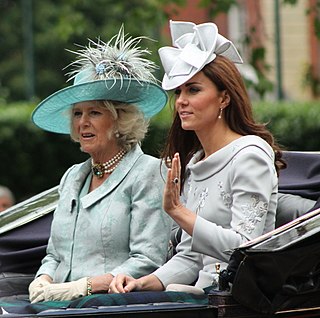
A picture hat or Gainsborough hat is an elaborate woman's hat with a wide brim. It has been suggested that the name may be derived from the way the broad brim frames the face to create a "picture".
Garren is an American hairstylist. He has worked in the fashion industry since the 1970s.

Seiko-chan cut (聖子ちゃんカット) is a popular name for a kind of feathered hairstyle, named after and popularized by Japanese pop singer and idol Seiko Matsuda, although the hairstyle itself predated Matsuda's debut. The hairstyle was popular among young Japanese women in the 80s. It is a layered haircut that hides the eyebrows with bangs, and the sides are blown outwards and the back is curled inwards.


















